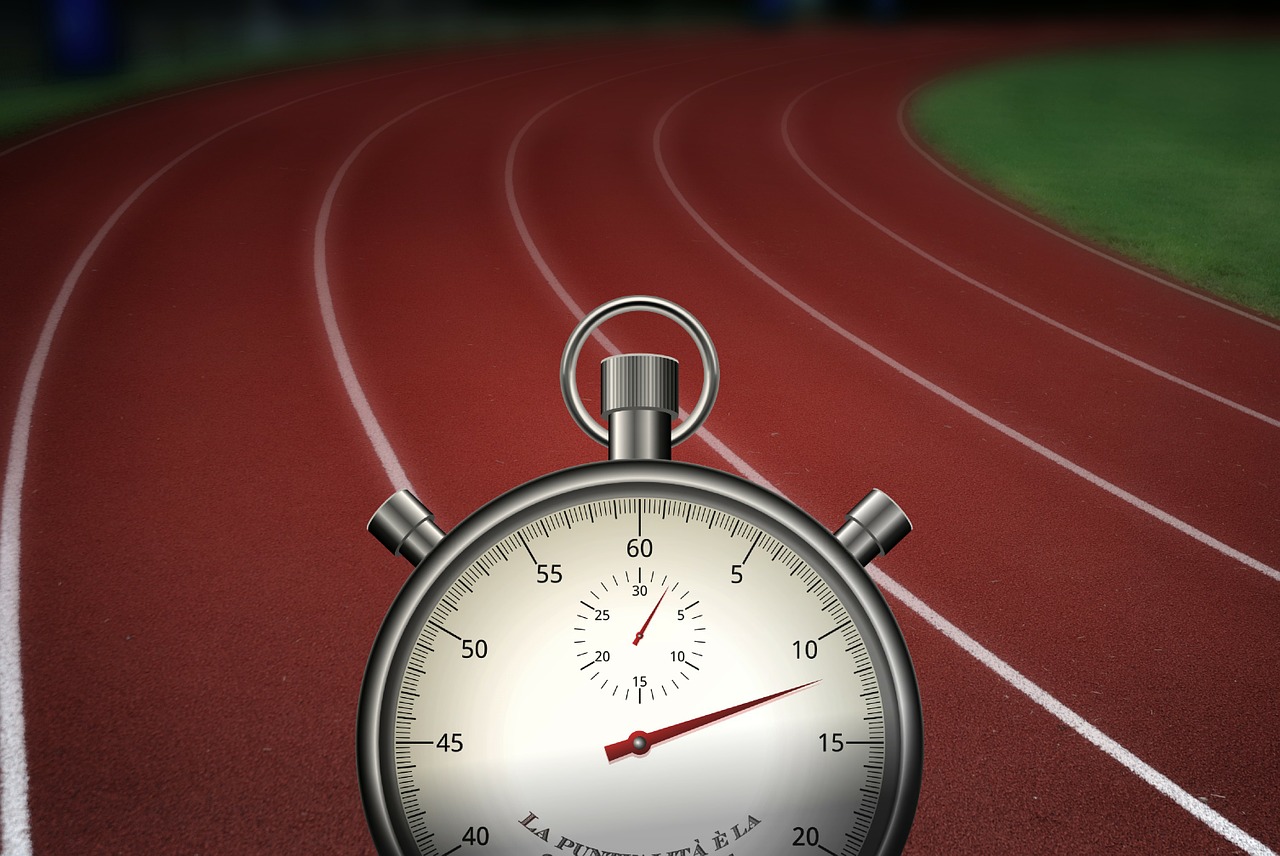
by EM2WL | Oct 9, 2014 | Cardio, Fat Loss / Cutting
How to Maximize Gym Time
Let’s face it, life is busy. Whether we’re single, married, have ten kids, have no kids, in school, working, you name it- we’re always racing the clock! Although our schedules are hectic, many of us realize the importance of finding time in our day to squeeze in some exercise. When working with a limited slot of time, we want to find ways to optimize that part of our day so we can be efficient, work hard, and get results. There are certain things that we can do to maximize our gym time and get more bang for our buck.
Have a Plan
 Unless this is your first time ever reading this blog or hearing from me, you know that my biggest pet-peeve (and with good reason!) is to see (or even HEAR) about people wandering aimlessly about life – well, at least the fitness side of it – with no plan. Ack! I mean, unless you are completely new to working out, or testing out gym equipment is your hobby, get a plan – and work that baby. Not only is following some sort of plan best for maximizing gym time, but it’s best for maximizing RESULTS! In other words, if you want to workout with purpose, having a plan is non-negotiable.
Unless this is your first time ever reading this blog or hearing from me, you know that my biggest pet-peeve (and with good reason!) is to see (or even HEAR) about people wandering aimlessly about life – well, at least the fitness side of it – with no plan. Ack! I mean, unless you are completely new to working out, or testing out gym equipment is your hobby, get a plan – and work that baby. Not only is following some sort of plan best for maximizing gym time, but it’s best for maximizing RESULTS! In other words, if you want to workout with purpose, having a plan is non-negotiable.
Random workouts – especially once you move past the newbie gain phase – often equal random results. You may ultimately desire to move to a more intuitive style of workouts, but when time is of the essence and you’re not quite familiar with how certain things fit – just stick to the plan.
Trust me, I’ve been there, and I know how easy it is to get sucked into the “atmosphere” and completely lose 2 hours of your day before feeling like you’ve done enough to warrant leaving. I also know that amount of time is completely unnecessary, and is typically a contributing factor to why many of us will totally scrap our workout if we’re running short on time. If you have a plan (preferably created by a professional, unless you are familiar with periodization and putting together effective workout combos) you have an accurate measure of how “done” you are at any given time increments. Let your trainer know that you are time crunched, or search out specifically, workout plans that fit with your goals and available time slots. Don’t follow some random 6-day, 1hour/day, workout split if you only have time to hit the gym 3 days/wk for 30-45 min, tops.
Have a Plan B
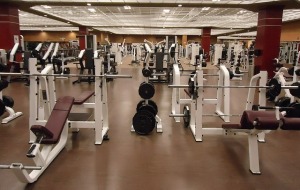
Your gym not this big OR empty? Have a Plan B!
This is where the OCD-plan-follower can relax a bit, and the ADD exerciser can rejoice. Yes, an overall, solid, plan is first and foremost, but remind yourself that it’s OK (and often necessary) to be flexible. Why? Because there will be a time that you get to the gym, totally pumped to hit the squat rack. You’ll head in, struttin your stuff with your Converses and new beasty, striped knee-high socks, and bam – all squat racks taken. Argh! This happens a lot in busier gyms during peak times. Don’t rely on one particular piece of equipment for your exercises. Have an idea of what you want to do, but don’t be married to it.
For instance: If it’s leg day – and you’re scheduled to do squats – you’re good no matter what, because you have a backup plan. Full squat racks aren’t stopping you, it’s off to the hack squat machine or an empty area to do squats with dumbbells. Bench day and no rack available? Head for the Smith machine (add extra weight to make up the bar weight difference), or take a set of dumbbells or even the straight curl bar (many gyms have up to 120 lbs) over to the free weight adjustable bench area.
Now this does NOT mean that you should take a professionally written program and chop it up by doing your own take on EVERY move, but you should know how to if you ever truly needed. Take the time on a less busy/off day to get to know alternate pieces of equipment that can generally get the job done (or ask your trainer if you’re working a plan they’ve given you). Often there are pieces of equipment that look completely different, yet perform similar functions (like the seated vs lying leg curl machines)
Superset
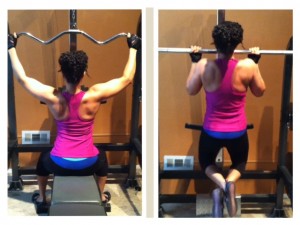
Total Body Supersets Workout Plan
When pressed for time, supersets can be a godsend.
Supersets consist of doing two exercises back to back with no rest in between. You can do exercises for either the same or different muscle groups. For example, you can use the rope attachment on a cable machine and do overhead tricep extensions, one set, and then move the rope down a little and do regular tricep extensions, one set, and repeat. Minimizing time between sets not only does the obvious- saves time- but it really adds a burn to the muscles, as it works muscle fibers differently than normal-set weight training.
Tri-sets (three exercises done back to back), and giant sets (four or more exercises done in a row) also fit into this category. With all supersets, you perform the entire set of two or more exercises, then rest as instructed in your program. If no rest period is indicated, typically 30 seconds is appropriate.
Word of caution for the ladies. Many ladies who are drawn to more endurance style workouts will enjoy supersets because they will feel like they are truly “working” – but I would be cautious of falling into the superset trap of thinking that every thing is better when superset. Sometimes longer rests are called for, and necessary, even in shorter workouts – depending on the phase. So if you are always short on time in the gym, be sure to switch up the types of supersets you do (one month superset the same muscle group, the next month group opposing parts, etc), when the supersets are performed in the workout (on every set one month, on every other set the next, etc), and from time to time put supersets aside altogether for an entire phase or two.
Do High Intensity Interval Training
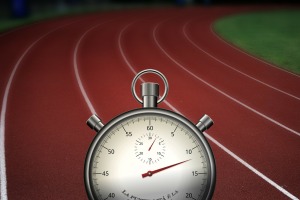 HIIT is praised mostly for two reasons – one, it is a huge time saver and two – the intensity level leads to quicker results than regular cardio and puts your body in a calorie burning state for hours after. Imagine swapping that twenty minute trek on the dreadmill with a quick eight minute sprint session. Suddenly, you’ve gained twelve minutes that you can use to do strength training, ab exercises, stretching, etc. This means that if you were used to splitting up your strength and cardio work to two separate workouts of an hour or so, you can now condense them both into ONE workout that is an hour or less.
HIIT is praised mostly for two reasons – one, it is a huge time saver and two – the intensity level leads to quicker results than regular cardio and puts your body in a calorie burning state for hours after. Imagine swapping that twenty minute trek on the dreadmill with a quick eight minute sprint session. Suddenly, you’ve gained twelve minutes that you can use to do strength training, ab exercises, stretching, etc. This means that if you were used to splitting up your strength and cardio work to two separate workouts of an hour or so, you can now condense them both into ONE workout that is an hour or less.
Try adding true HIIT or Tabata finishers to your strength workouts, rather than dedicating an entire day to each. What do I mean by “true?” Well, because HIIT has become all the rage, we are now bombarded with HIIT workouts popping up left and right ranging anywhere from 10-60 minutes. While they may all be hard in their own right, true HIIT brings the intensity like no other. Intensity meaning that if you can do any interval for longer than 30ish seconds, or any workout lasting longer than 20ish minutes (not including any warmup/cooldown)…it’s not hard enough. You need super intense intervals where you are going at a crazy, all-out (RPE 10+) effort for 20-30 seconds (and absolutely can’t go longer even if you wanted), and then resting for another 20-30 before repeating. This type of training is short and to the point, making it perfect to tack on to the end of you workout.
A couple words of warning with HIIT. 1) It’s not for everyone, allow yourself to work up to it if you’re newer to working out (perhaps with one of the HIIT-like workouts with longer duration or intervals mentioned above). 2) If a 20 minute HIIT workout early in the AM leaves you worn out and more sedentary than usual for the rest of the day – you are negating the benefits of the afterburn. You may want to stick to 30-40 min of a different cardio activity that will still allow you to get in normal amounts of daily activity/productivity every day.
Stay Focused
 Above all, the most important way to maximize your workout is to have laser beam focus. Don’t stress over having to shorten your gym time for a season. Be fully present, engaged in the workout, giving it your all, and knowing that it’s enough. If you head into a workout feeling obligated, and like you just have to get it done to get it out of the way, you won’t be as efficient as possible. If you practice negative self-talk and feel that working out serves as a form of punishment for bad food choices, you’ll have a hard time finding yourself getting in a good sweat (or being satisfied with a less sweaty workout). Remembering why you choose to be active is important, encouraging part of your journey. While physical benefits (toned muscles, smaller waistlines) are a nice perk of working out, living a healthier and happier life far surpass them all.
Above all, the most important way to maximize your workout is to have laser beam focus. Don’t stress over having to shorten your gym time for a season. Be fully present, engaged in the workout, giving it your all, and knowing that it’s enough. If you head into a workout feeling obligated, and like you just have to get it done to get it out of the way, you won’t be as efficient as possible. If you practice negative self-talk and feel that working out serves as a form of punishment for bad food choices, you’ll have a hard time finding yourself getting in a good sweat (or being satisfied with a less sweaty workout). Remembering why you choose to be active is important, encouraging part of your journey. While physical benefits (toned muscles, smaller waistlines) are a nice perk of working out, living a healthier and happier life far surpass them all.
Photo Cred: Danilo Rizzuti

by | Oct 2, 2014 | Building Muscle, TDEE/BMR, Troubleshooting
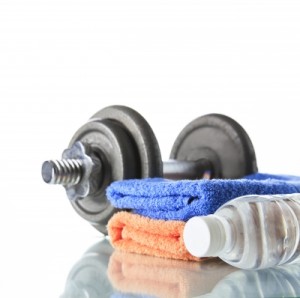 Experienced lifters know the importance of rest between sets, which can be anywhere from 30-90 seconds, depending on how quickly you recover. They also know that rest days from weight lifting — even during the week — are important, and structure their sessions so they can train one body part while the others are getting a rest. But, did you know that it is even more important to take an entire week off from strength training?
Experienced lifters know the importance of rest between sets, which can be anywhere from 30-90 seconds, depending on how quickly you recover. They also know that rest days from weight lifting — even during the week — are important, and structure their sessions so they can train one body part while the others are getting a rest. But, did you know that it is even more important to take an entire week off from strength training?
Some refer to rest weeks as de-load or recovery weeks. Whatever you prefer to call them, they are necessary. This is an opportunity to give your entire body rest from lifting heavy weights, and even from high intensity cardiovascular workouts that put a strain on the body and the mind.
Rest weeks are unfortunately over looked by many weightlifters — especially newbies — because they think the few days during the week that they rest (if they rest) is enough. They have the “no pain, no gain” mentality. They feel that the more they do, the better and stronger they will get and the quicker they will reach their goal. Actually, failing to take longer breaks will affect your progress in a negative way.
This magic of building muscle does not happen while you are actually lifting the weights. Instead, it happens while you rest. Surprised? Yes, I was too! When you lift weights to build muscle, you are tearing the small muscle fibers. Quick science lesson…After you workout, your body begins to repair damaged muscle fibers through a cellular process where it pulls the fibers together to form new muscle protein strands, or myofibrils. These repaired myofibrils increase in thickness and number to create muscle growth. Muscle growth occurs whenever the rate of muscle protein synthesis is greater than the rate of muscle protein breakdown. All of this happens while you are not working out! This machine — called the body — is truly amazing!!
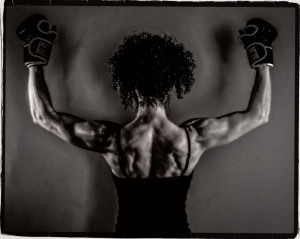
I know a whole week away from the iron may put some into withdrawal! But you can make it an active rest week where you’re engaged in your favorite sport or in low intensity cardio like walking, yoga, or your favorite aerobic DVD a couple of days during the week. But, no lifting or HIIT! And, don’t forget to continue to eat balanced meals of proteins, carbohydrates, and fats. It’s important to continue to feed those muscles while they are repairing. This simply means DO NOT restrict or lower your calories because you are not working out as much! In fact, it may be a good idea to eat at your TDEE along with making good food choices during this rest period. If you are cutting during your recovery, you may want to decrease your deficit from 10% to 5%. You want to make sure any losses that week are not muscle. Remember, the whole point of recovery week is for your muscles to have a chance to repair. So, don’t plan to run a marathon during this time!!
If you’ve been lifting weights and/or doing high intensity workouts and have not taken a rest week, you are well overdue for a much needed break. It’s a good idea to plan a rest week every 4 to 5 weeks to let that muscle rest, repair, and grow. Then the weeks following your rest, you will feel refreshed, energized and ready to take your performance to the next level.
Photo credit: stockimages, naypong
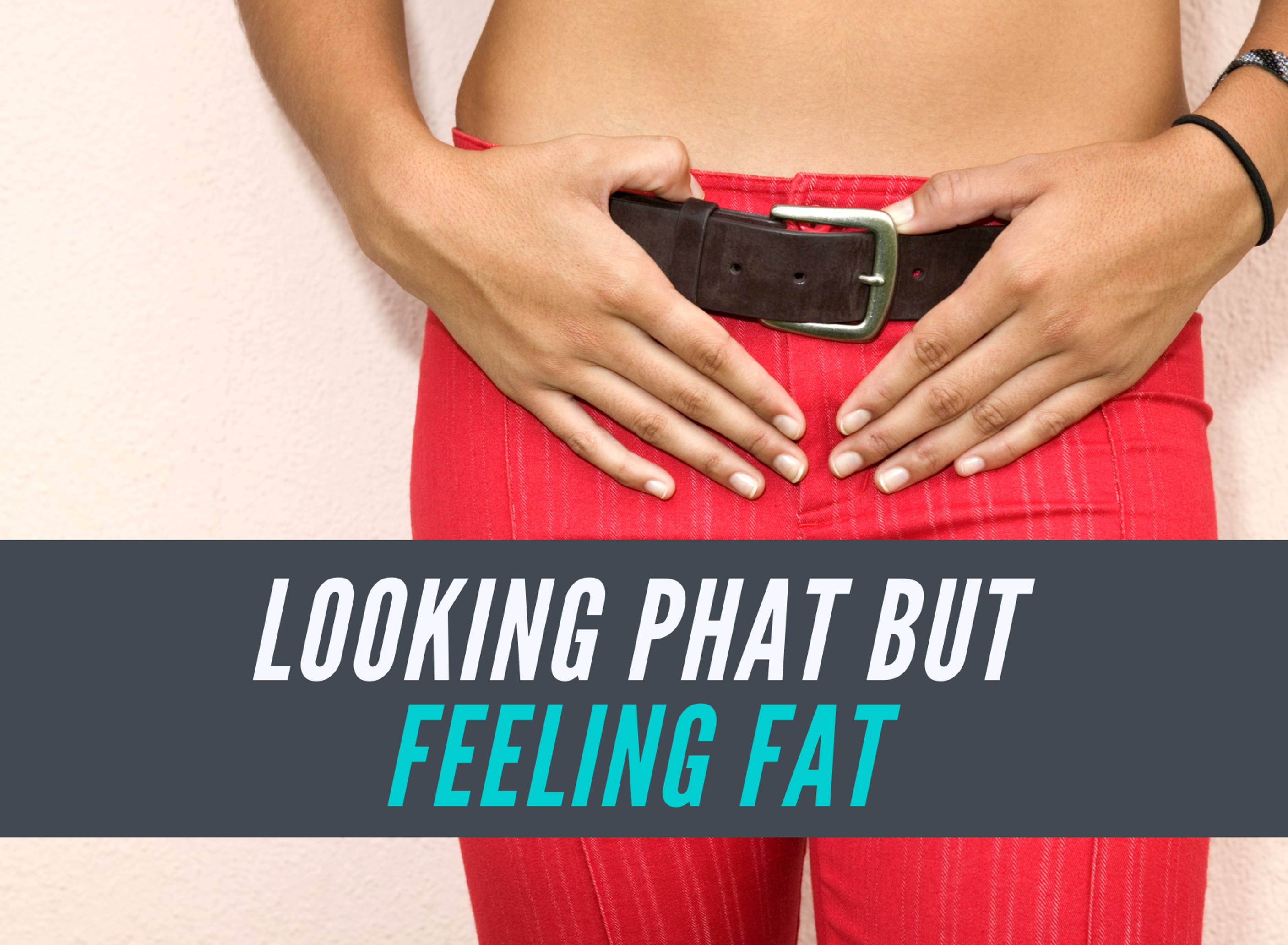
by EM2WL | Sep 24, 2014 | Building Muscle, Fat Loss / Cutting, Motivation
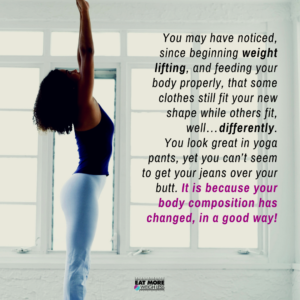 You may have noticed, since beginning weight lifting, and feeding your body properly, that some clothes still fit your new shape while others fit, well…differently. You look great in yoga pants, yet you can’t seem to get your jeans over your butt. You look great naked, but when you put on those shorts your thighs look like… “quadzilla??” Perhaps you weigh the same as you did before, or maybe you’ve gained a few extra pounds. A quick measurement check reveals that though you have lost inches in some areas, you’ve actually gained inches in others.
You may have noticed, since beginning weight lifting, and feeding your body properly, that some clothes still fit your new shape while others fit, well…differently. You look great in yoga pants, yet you can’t seem to get your jeans over your butt. You look great naked, but when you put on those shorts your thighs look like… “quadzilla??” Perhaps you weigh the same as you did before, or maybe you’ve gained a few extra pounds. A quick measurement check reveals that though you have lost inches in some areas, you’ve actually gained inches in others.
Is this supposed to be happening?
The answer is: Yes. It is because your body composition has changed, in a good way! Body composition is the proportion of fat, muscle and bone that make up the body. It is measured by the percentage of body fat and the percentage of lean body mass that you have. Resistance training along with an appropriate calorie intake, and proper macronutrients is the foundation of these amazing changes.
When I decided to make fat loss my ultimate goal — by adding resistance training to my workouts — I assumed that meant I would automatically fit into a smaller size. I slowly saw the changes to my body in the mirror and I loved what I was beginning to see. I embraced the slimming in some areas and the new curves in others. But when I went shopping for new pants, I would get discouraged. The sizes and styles that I tried on, thinking they should fit…didn’t. The smaller sizes were a little too tight in the hips, the larger sizes were too big in the waist! When I tried on shirts, some were tight around the biceps while others were tight across the back and chest.
But I didn’t give up.
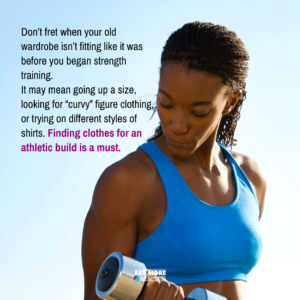 As I continued to try on different styles, sizes, and designers, I finally found a rack of designer pants that made classic, straight, and curvy fit. Yay! I chose one of each cut, in 2 different sizes. The curvy pant was made just for me. I turned from side to side admiring how awesome I looked and felt. But soon reality hit…
As I continued to try on different styles, sizes, and designers, I finally found a rack of designer pants that made classic, straight, and curvy fit. Yay! I chose one of each cut, in 2 different sizes. The curvy pant was made just for me. I turned from side to side admiring how awesome I looked and felt. But soon reality hit…
It was one size larger than what I thought I should be in. I found myself depressed over a number some guy put on a label inside a pair of pants. Shame on me!! I loved the way I looked and felt. I decided that it was time for me to ditch the number on the label in my pants like I did the scale!
So don’t fret when your old wardrobe isn’t fitting like it was before you began strength training. Look for a designer that makes clothes for your female figure. We really need to stop buying clothes made by designers who think women are shaped like 12-year-old boys. It may mean going up a size, looking for “curvy” figure clothing like I did, or trying on different styles of shirts, but finding clothes for an athletic build is a must.
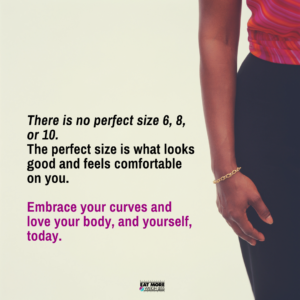 If you have been in the department stores lately you will also see beautiful long skirts and palazzo pants in gorgeous fall solid colors and prints that are perfect for figures between sizes. Many of these have elastic waistbands that will fit as you continue to lose fat, so you won’t have to buy smaller sizes! It’s important to choose clothing that not only looks fashionable, but also feels comfortable!
If you have been in the department stores lately you will also see beautiful long skirts and palazzo pants in gorgeous fall solid colors and prints that are perfect for figures between sizes. Many of these have elastic waistbands that will fit as you continue to lose fat, so you won’t have to buy smaller sizes! It’s important to choose clothing that not only looks fashionable, but also feels comfortable!
Remember, there is no perfect size 6, 8, or 10. The perfect size is what looks good and feels comfortable on you.
Embrace your new curves and love your body, and yourself, today.
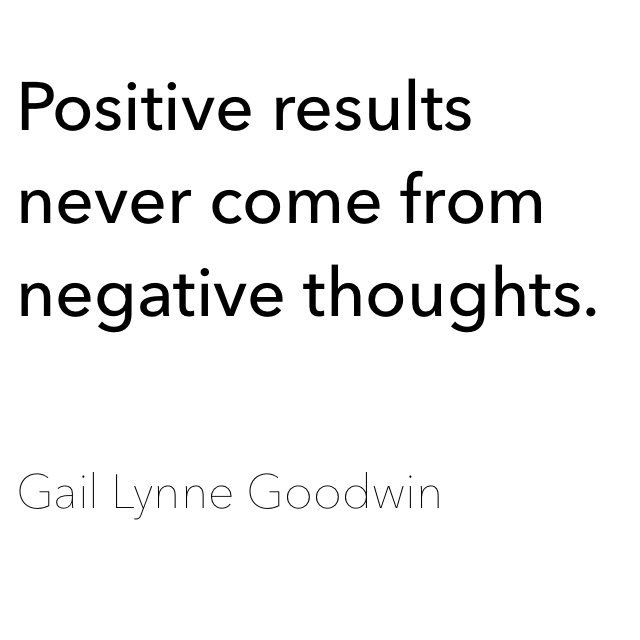
by Trish Adams | Sep 15, 2014 | Consistency, Fat Loss / Cutting, Motivation
Self-doubt happens to all of us at some point in our lives. On the journey to reaching a specific goal, negative thoughts make us question if we can achieve the very thing that we set out to accomplish. It’s these negative thoughts, when left untamed, which can affect our actions and lead to negative results.
Our patience can be particularly tested when it comes to reaching physique, strength, fitness or health-related goals where results are slow, or we feel we have less control over the outcome. Learning to catch negative thoughts as they happen is key to avoiding the slippery slope of negativity and ensuring you stay on the path you have set out on with a grateful, and optimistic outlook.
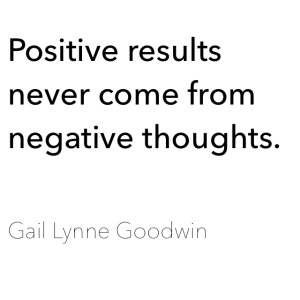 Let’s use this scenario as an example. You head to the gym on a Monday and have an awesome lift. You’re feeling good about yourself because you added 10 pounds to your bench and 20 pounds to your deadlift. In short, you feel like a BEAST!!! You wake up the next day, rush to the mirror and promptly start looking for changes, expecting to be rewarded for all your hard work (or…at very least, another glance at those gorgeous muscles you saw poppin yesterday). Instead you feel fluffy — not at all what you expected — and you’re holding water (100% normal following an incredible lift session!). Suddenly your attitude towards the day goes from “I’m ready for you!” to “Why should I even stay on track or hit the gym today?” Negative thoughts start to creep in and you’re convinced you have failed.
Let’s use this scenario as an example. You head to the gym on a Monday and have an awesome lift. You’re feeling good about yourself because you added 10 pounds to your bench and 20 pounds to your deadlift. In short, you feel like a BEAST!!! You wake up the next day, rush to the mirror and promptly start looking for changes, expecting to be rewarded for all your hard work (or…at very least, another glance at those gorgeous muscles you saw poppin yesterday). Instead you feel fluffy — not at all what you expected — and you’re holding water (100% normal following an incredible lift session!). Suddenly your attitude towards the day goes from “I’m ready for you!” to “Why should I even stay on track or hit the gym today?” Negative thoughts start to creep in and you’re convinced you have failed.
Wait. Wait, wait!
This is when you have to practice stopping those negative thoughts in their tracks. Try using the following tactics to keep your mind focused on the positive and stay headed in the right direction.
Remember how far you’ve come – On days where you’re struggling with the person in the mirror, or worse, the number on the scale, remember all that you have accomplished. Are you a reformed VLCD eater who now nourishes their body with the nutrients it needs? Are you a recovering binge-eater who no longer feels out of control when eating trigger foods? Have you overcome any physical challenges like being able to play with your kids without getting winded or, heck, maybe you can push a car! These are all victories that don’t reflect back to us when we are looking in the mirror or standing on the scale. Each and every one, no matter how big or small, should be acknowledged (often), celebrated, and used as fuel to push on.
Try something new – If you do the same routines week in and week out, it might be time for a change. Scratch that, i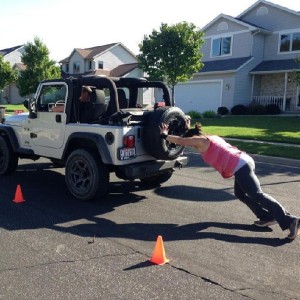 t most definitely is time for a change! Consider adding phases to your routine to be sure that you are getting the most out of your efforts. At a minimum, try a new exercise class, take your workout outside or invite a friend to the gym. Change it up. You will be amazed by your body’s ability to adapt to something new.
t most definitely is time for a change! Consider adding phases to your routine to be sure that you are getting the most out of your efforts. At a minimum, try a new exercise class, take your workout outside or invite a friend to the gym. Change it up. You will be amazed by your body’s ability to adapt to something new.
Be grateful for what you have – There are people who don’t have the health that allows them to get up every day and work out. Understand you are blessed to have this opportunity. View exercise as a way to thank your body for all it is capable of. Every day that you are able to push harder and get stronger is a gift.
Doubt can creep up at any time, not just during our weakest moments. Next time you feel a negative thought coming on, counter it with a positive one. Instead of thinking “my stomach looks puffy today,” try saying something like “I have strong, muscular legs.” Don’t let negative thoughts take you off the course you have set for yourself. Win these small battles one at a time. Your mind believes what you tell it, whether it is fact or fiction. Be sure you are feeding it positive thoughts.
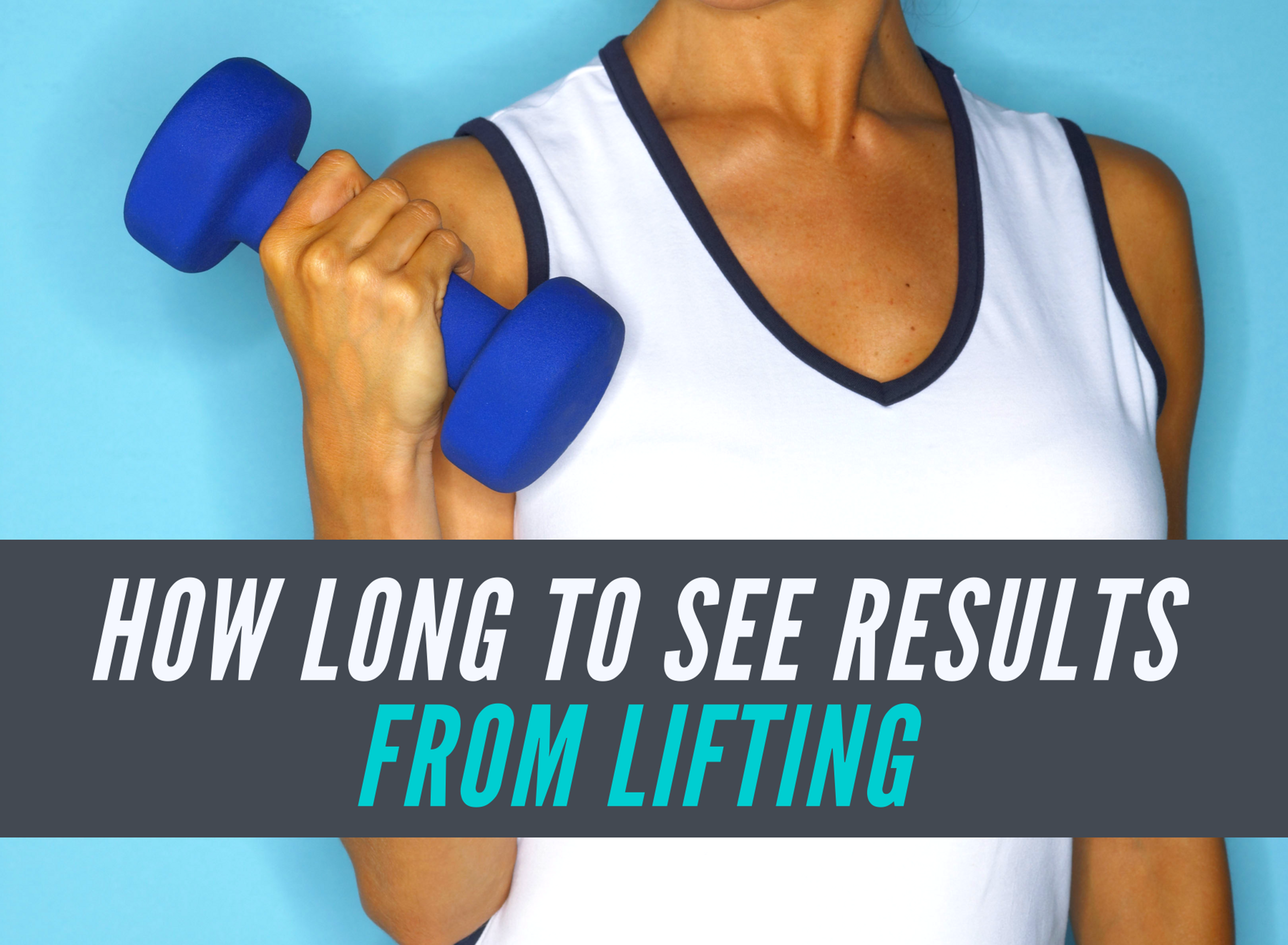
by EM2WL | Sep 11, 2014 | Building Muscle, Consistency, Fat Loss / Cutting
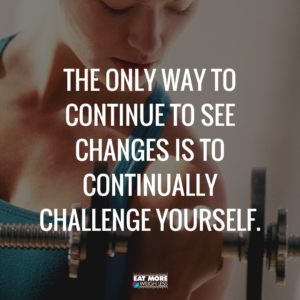
If you’re newer to lifting, or perhaps just newer to lifting heavy – at some point you’ll wanna know just how long to see results from lifting.
Back in the day, it was easier to avoid the message that “lifting heavy changes your body, ” but lately it seems that most fit pros and enthusiasts have finally hopped on board. Whether you’ve decided to test the waters with Crossfit, finally hired a trainer, or simply do some workouts that you find on the internet: you’re lifting heavy, you’re loving it…and you’re not seeing these “miraculous” changes that everyone seems to be promoting. What.is.the.deal?
Here’s eight reasons why you may not be seeing results yet:
You still aren’t lifting heavy enough
I’m sure this is insulting to most people reading this. I mean, of course you’re lifting heavy enough. It’s a heavy weight, and you feel the burn when you lift it. Every body part requires a different weight. So if you’re using only one or two weight sizes, for your entire body – then it’s not possibly heavy enough for every area. A dumbbell of 10-12 pounds may be excruciatingly heavy for your smaller muscle groups like rear delts, but most ladies can lift much more than that for a back, chest, or leg movement. If you’re able to go beyond 12 reps on most exercises, it’s probably time to increase your weight.
Don’t think that you hard-core-iron-heads are exempt from this one. Sometimes, vets, we can be just as likely to get comfy with a certain weight. Are you’re cranking out 25lb dumbbell rows, just because it seems heavy enough for your 10-12 rep range? Or because it’s the highest weight available? Could you possibly go up to 30 or 35? Who cares if you can only make it to six to eight reps before you fail? Accept the challenge — if you can do it with good form — and work your way back up to 10 reps. If you can’t make such a huge jump, add some weighted gloves and increase by only two to four pounds at a time rather than the entire five. Either way, find your max for that number of reps, and then push past it. The only way to continue to see changes is to continually challenge yourself.
You’re basing your “results” judgement on a scale number
We’ll often hear from ladies who are lifting and aiming for fat loss say things like “I must be doing something wrong…I should have lost ‘X’ pounds/dress sizes by now”
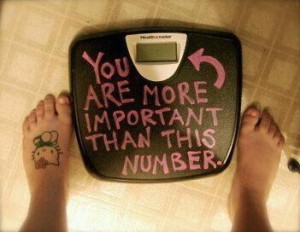 Ummm…Says who??? ;) How do we determine how many sizes we should be up or down within a year? I pray not by the same industry standards that tell us to “eat-less-than-you-need-to-support-your-body-in-a-comatose-state” for weight loss?
Ummm…Says who??? ;) How do we determine how many sizes we should be up or down within a year? I pray not by the same industry standards that tell us to “eat-less-than-you-need-to-support-your-body-in-a-comatose-state” for weight loss?
Sure…there will always be tweaks that you’ll want to make, but if your butt looks freakin amazing – take a moment to accept that, rather than be overly concerned about the number on the scale OR inside of your jeans.
Too many of us are still being held captive by our scale weight…or some other tracking method that doesn’t take into account the type of changes that are happening. Case in point: my pant size can vary from a size two to TEN in about 60 seconds (yet look just as lean in either size). How is this possible? My butt has seriously gotten so high that it ranges from one extreme to the other, based on the rise (and brand) of the jeans. If your body shape is changing, maybe it’s time to switch brand manufacturers. It sucks, but sometimes must be done. Trust me, you will see how great you look in clothes that fit. Every fashion book/expert on the market (that’s worth a darn) will tell you to stop giving two hoots about sizes. This is because no matter how small you are, sizes will vary — per person — in fit. FIT is everything.
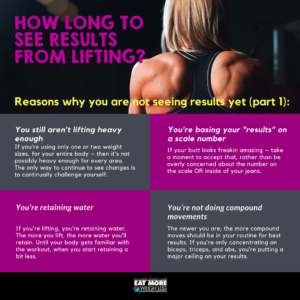 Confession time: The other day, I went out in frustration over all my older, lower rise jeans that weren’t fitting. Taking my own redundant advice — I bit the bullet and bought the exact same jeans in LARGER sizes to make sure they fit over my butt. Listen…the size was WAY larger…would you know I had FIVE people tell me I need to STOP losing weight when I was wearing those jeans?! I have gained over 10 lbs (apparently all in the bootay)!! But wearing jeans that FIT ME (note…did not say jeans that “I fit” into to) FIT, baby. Get clothes that fit, forget the rest. By the time you can squeeze into jeans from over a year ago, they’re probably outdated anyway :P
Confession time: The other day, I went out in frustration over all my older, lower rise jeans that weren’t fitting. Taking my own redundant advice — I bit the bullet and bought the exact same jeans in LARGER sizes to make sure they fit over my butt. Listen…the size was WAY larger…would you know I had FIVE people tell me I need to STOP losing weight when I was wearing those jeans?! I have gained over 10 lbs (apparently all in the bootay)!! But wearing jeans that FIT ME (note…did not say jeans that “I fit” into to) FIT, baby. Get clothes that fit, forget the rest. By the time you can squeeze into jeans from over a year ago, they’re probably outdated anyway :P
You’re retaining water
Yeah, yeah…we’re all tired of this excuse. But let’s face it. If you’re lifting, you’re retaining water. Sometimes LOTS of water. The more you lift, the more water you’ll retain. If you’re doing tons of HIIT, then consider it the cherry on top of your water-retention-sundae. Until your body gets familiar with the workout, when you start retaining a bit less. But then you change it again. And retain more water. It’s an ugly cycle. But not really. It is what it is. Ladies, we really have to get over this whole “water weight” thing. The more muscle mass you build, the more water you’ll begin to retain at all times. This really isn’t such a bad thing, but rather a sign that things are going well…as you’ll see here. But this does mean that you’ll have to give those scale dreams a rest, and focus on all the goodness and shifting that’s happening with your body. When it comes to lifting, things will occasionally appear to get worse before they get better. I just consider it the “labor pains” of muscle delivery — a tad “painful” when it’s happening, but most of us wouldn’t trade that muscle baby for the world once it arrives. ;)
Side note: If you’re totally convinced/upset/depressed that your pants are getting tighter, perhaps you need to cut down on low rep squatting for a while? Work your lower rep squatting in in phases, so that you still get the muscle building benefits, but aren’t constantly retaining water. But, if you adore your 5×5 deadlifts or what have you, just accept that you may be retaining some serious water…and invest in jeggings.
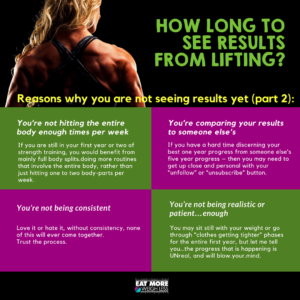 You’re not doing compound movements
You’re not doing compound movements
If you’re not seeing major body changes, it could be for lack of major body movements. If you’re hitting the gym and only concentrating on biceps, triceps, and abs, you’re putting a major ceiling on your results. Compound movements are the basis of most effective routines for a reason. They work in the actual way that your body works, strengthening your joints and tendons (in addition to your muscles), working multiple muscle groups at once, and burning more calories overall than an isolated move hitting the same muscle group would. Obviously, there’s a time and place for everything, including isolated moves, but generally the newer you are, the more compound moves should be in your routine for best results.
You’re not hitting the entire body enough times per week
As with compound moves, newbies should be doing more routines that involve the entire body, rather than just hitting one to two body-parts per week. The traditional splits that are seen in the bodybuilding community work extremely effectively…for veteran bodybuilders. If you are still in your first year or two of strength training, you would benefit from mainly full body splits. Not only do these types of workouts get the heart rate up higher, they also produce faster results. Generally speaking, the less amount of time you’ve been lifting, the more often you can work that body-part per week. A typical newbie routine could consist of up to 3 total body workouts per week, or 2 upper, 2 lower (alternating). The opposite often holds true for vet lifters who need more rest per part — hitting the body part hard, with higher volume, 1-2xs/week, max is optimal and prevent over-training.
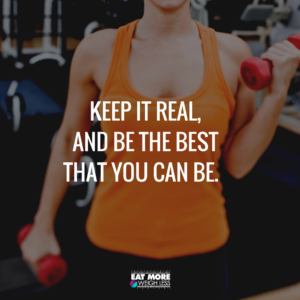 You’re comparing your results to someone else’s
You’re comparing your results to someone else’s
Try not to compare yourself to anyone else. If you feel the need to look around for an ideal body goal to shoot for, make sure that it aligns with YOUR genetics, time, interest, and drive. Most importantly, note their starting point. There’s no point in shooting to look like a pro figure competitor, when you don’t have the inclination or desire to put in the time that they do. There’s also no use comparing yourself to someone who has taken over a decade to attain their body, and bashing yourself for not accomplishing similar results in your first year of lifting. Hint: most women you see in fitness magazines, Instagram, or the internet — with any amount of muscle “tone” — have put in years of serious training and eating (and/or have been photoshopped…but I digress). Keep it real, and be the best that you can be. If you have a hard time discerning your best one year progress from someone else’s five year progress – then you may need to get up close and personal with your “unfollow” or “unsubscribe” button. Don’t keep images, magazines, or Facebook “friends” around that make you feel that you’re accomplishing nothing. Surround yourself with pictures of yourself, and compare new pictures of yourself to the ones from the beginning of this journey. (But please don’t compare pics of your 40 year old self to pics of your 15 year old self…that’s just plain freaky)
You’re not being consistent
Love it or hate it, without consistency, none of this will ever come together. If someone lifts, gets frustrated because the results aren’t coming fast enough, and then goes back to cardio madness, they will be convinced that nothing is working. Repeatedly lowering cals in a muscle building phase, or under-cutting rest periods in a strength phase, or only sticking to a workout for a couple of weeks before switching “back” is a recipe for disaster. Trust the process. As mentioned previously, most lifters with ultra defined musculature took years, upon years, upon Y.E.A.R.S. to develop. Getting frustrated because you don’t look like a person on a magazine/DVD cover, your personal trainer, or (fill-in-the-blank) WFBB Pro, after completing a 4-12 week program will not make the process go any faster. In fact, it makes take wayyyy longer. Think of your journey as a college degree, every time you “change your major” you tack on time to your journey. If you plan on seeing some impressive results, you’ve gotta buckle down, make the decision, and stick.with.it. Constantly doubting, and thinking that things aren’t working — creates the exact environment you’re expecting.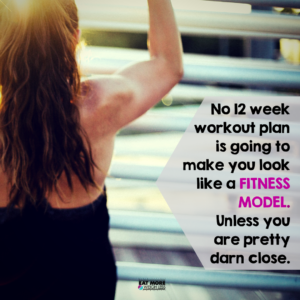
You’re not being realistic or patient…enough
It’s really hard to put your lifting progress on a timetable. Especially in the first year or so of lifting when you’re getting the most coveted results of any lifter: newbie gains. losing fat and gaining muscle at the same time. It will never again happen in your lifetime of lifting, but it can’t be measured by typical dieting methods of measurement. You may sit still with your weight or go through “clothes getting tighter” phases for the entire first year, but let me tell you…the progress that is happening is UNreal, and will blow.your.mind. It’s just sad that so many of us come from a dieting standpoint and expect things to be so perfectly linear, that we never see results of all the hard work we put in come to fruition. We get scared, run back to “old” methods, and then when those methods “appear” to be working – we assume that it’s because we went back to the old stuff (cardio/circuits/super restrictive eating/starving), not actually understanding that it’s results of lifting that were there all along. So then we keep doing the old stuff, thinking that it will only get better, only eventually undo the results, and put ourselves back at square one.
Vets: how long did/has it taken you to see results? Any tips for a newbie or frustrated lifter that’s just not seeing the results they want?
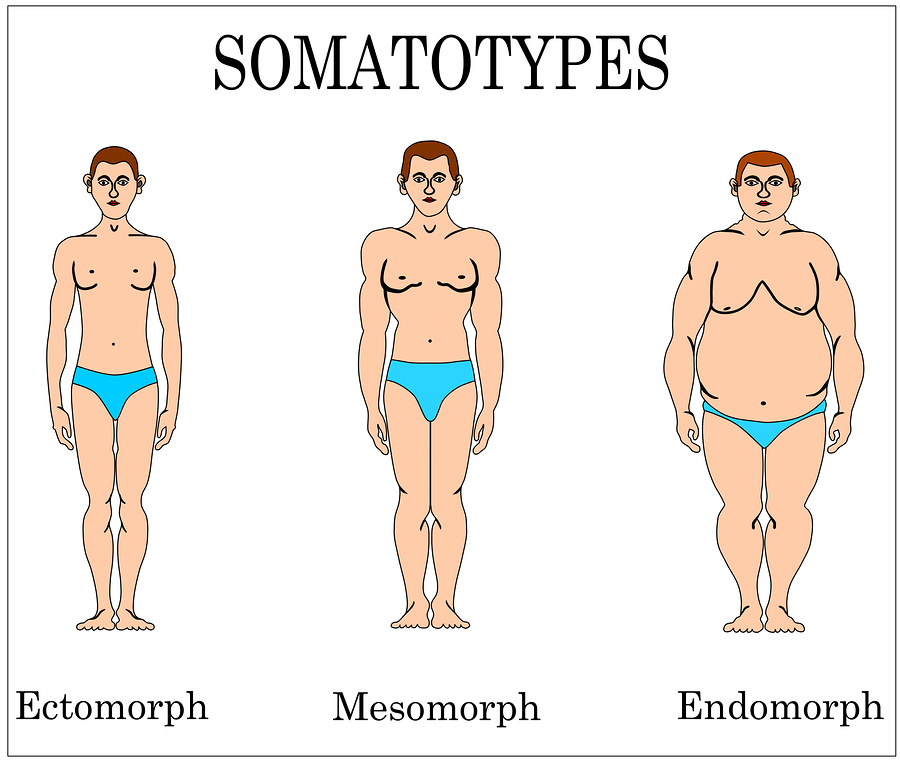
by Trish Adams | Sep 1, 2014 | Fat Loss / Cutting, Intuitive Eating, Nutrition
In part 1 of this series we reviewed the basics of macronutrients and why each one plays an important role in your diet. While it’s important to understand what macronutrients are and how they function in your body, what most of us want to know is how to turn that into practical information we can use in our daily lives.
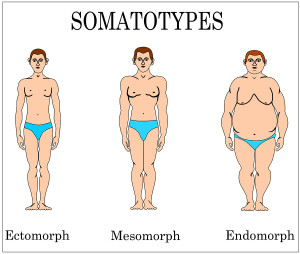 An approach often recommended and used by the EM2WL coaches is eating based on your body type. As with most things related to fitness, every body is unique and finding what works for you and your lifestyle takes some trial and observation. Two people with the same body type may have different diet histories, different external stressors, hormonal imbalances, etc. which may impact results even when eating the same diet. That being said, eating for your body type takes into account metabolic differences based on physical attributes and can guide you with your diet choices.
An approach often recommended and used by the EM2WL coaches is eating based on your body type. As with most things related to fitness, every body is unique and finding what works for you and your lifestyle takes some trial and observation. Two people with the same body type may have different diet histories, different external stressors, hormonal imbalances, etc. which may impact results even when eating the same diet. That being said, eating for your body type takes into account metabolic differences based on physical attributes and can guide you with your diet choices.
A somatotype, or body type as it is most commonly referred to, is a method of categorizing people based on their physique into one of three groups – endomorph, mesomorph, and ectomorph. It is believed that people with similar physiques share other characteristics, such as metabolism, which can inform one’s nutrition. Thus, determining your body type gives you a starting point with your macronutrient breakdown.
Ectomorph

Carbs, carbs, carbs!
Ectomorphs are naturally thin with smaller bone structures. Their metabolic rate is fast and they tolerate carbs well. You may think that having an ectomorph body type is like hitting the physique lottery, but it comes with its own set of challenges including being able to increase muscle mass or put on weight. For that reason, ectomorphs are also known as hard gainers. Because ectomorphs tolerate carbs well, they are prioritize in their diet.
For ectos, a good starting point would be: Carbohydrates 55%, Protein: 25%, Fat: 20%
Ok, I have to admit that having an ectomorph body type is definitely like hitting the food lottery!!
Mesomorph
Mesomorphs have athletic builds (i.e. V shape) with a medium bone structure. They are testosterone and growth hormone dominant which typically translates to more lean mass and lower body fat when active. Mesomorphs are generally able to eat what they want without encountering too many issues. They also aren’t too challenged when it comes to putting on or taking off weight.
Like ectomorphs, carbs are tolerated fairly well and play a starring role in a mesomorph meal plan: Carbohydrates 40%, Protein: 30%, Fat: 30%
Endomorph
Endomorphs have the largest bone structure and tend to carry more body fat as well as muscle mass. They tend to have pear shapes, gain weight easily and are often challenged when trying to lose weight. Endomorphs fair best with more fat and protein in their diet with carb intake kept at a moderate level and arranged around their activity.
pear shapes, gain weight easily and are often challenged when trying to lose weight. Endomorphs fair best with more fat and protein in their diet with carb intake kept at a moderate level and arranged around their activity.
An endomorphs’ intake might look like: Carbohydrates 25%, Protein: 35%, Fat: 40%
Choosing a Body Type Diet
If you’re wondering into which category your body falls or thinking that you could be categorized in more than one category, you’re probably right. Most people do in fact show characteristics of more than one body type.
Trying to fit perfectly into one category is not the goal here. Rather decide which category you feel you fit best in, choose the appropriate macro breakdown and adjust from there.  Undoubtedly many (primarily women) will try to fit into the endomorph category. Even classic ectomorphs will readily identify as an endomorph when trying to lose weight. However, I caution you NOT to immediately assume that your body type is endomorph simply because you are carrying “extra” body fat.
Undoubtedly many (primarily women) will try to fit into the endomorph category. Even classic ectomorphs will readily identify as an endomorph when trying to lose weight. However, I caution you NOT to immediately assume that your body type is endomorph simply because you are carrying “extra” body fat.
To help determine your body type, have a spouse or friend take a picture of you and compare the pic to the body type images (pictures are more objective than mirrors). You might be surprised to find which category you best align with.
Regardless of which category you best identify with, be sure to allow yourself sufficient time to evaluate how your body responds before making ANY changes. Then, once you feel you want to make an adjustment, start small and observe again. Over time you will determine what worked best for you and what didn’t.
Photo credit: Norbert Sobolewski, Egal, Ruthie, DenisNata/bigstockphoto.com

 Unless this is your first time ever reading this blog or hearing from me, you know that my biggest pet-peeve (and with good reason!) is to see (or even HEAR) about people wandering aimlessly about life – well, at least the fitness side of it – with no plan. Ack! I mean, unless you are completely new to working out, or testing out gym equipment is your hobby, get a plan – and work that baby. Not only is following some sort of plan best for maximizing gym time, but it’s best for maximizing RESULTS! In other words, if you want to workout with purpose, having a plan is non-negotiable.
Unless this is your first time ever reading this blog or hearing from me, you know that my biggest pet-peeve (and with good reason!) is to see (or even HEAR) about people wandering aimlessly about life – well, at least the fitness side of it – with no plan. Ack! I mean, unless you are completely new to working out, or testing out gym equipment is your hobby, get a plan – and work that baby. Not only is following some sort of plan best for maximizing gym time, but it’s best for maximizing RESULTS! In other words, if you want to workout with purpose, having a plan is non-negotiable. HIIT is praised mostly for two reasons – one, it is a huge time saver and two – the intensity level leads to quicker results than regular cardio and puts your body in a calorie burning state for hours after. Imagine swapping that twenty minute trek on the dreadmill with a quick eight minute sprint session. Suddenly, you’ve gained twelve minutes that you can use to do strength training, ab exercises, stretching, etc. This means that if you were used to splitting up your strength and cardio work to two separate workouts of an hour or so, you can now condense them both into ONE workout that is an hour or less.
HIIT is praised mostly for two reasons – one, it is a huge time saver and two – the intensity level leads to quicker results than regular cardio and puts your body in a calorie burning state for hours after. Imagine swapping that twenty minute trek on the dreadmill with a quick eight minute sprint session. Suddenly, you’ve gained twelve minutes that you can use to do strength training, ab exercises, stretching, etc. This means that if you were used to splitting up your strength and cardio work to two separate workouts of an hour or so, you can now condense them both into ONE workout that is an hour or less. Above all, the most important way to maximize your workout is to have laser beam focus. Don’t stress over having to shorten your gym time for a season. Be fully present, engaged in the workout, giving it your all, and knowing that it’s enough. If you head into a workout feeling obligated, and like you just have to get it done to get it out of the way, you won’t be as efficient as possible. If you practice negative self-talk and feel that working out serves as a form of punishment for bad food choices, you’ll have a hard time finding yourself getting in a good sweat (or being satisfied with a less sweaty workout). Remembering why you choose to be active is important, encouraging part of your journey. While physical benefits (toned muscles, smaller waistlines) are a nice perk of working out, living a healthier and happier life far surpass them all.
Above all, the most important way to maximize your workout is to have laser beam focus. Don’t stress over having to shorten your gym time for a season. Be fully present, engaged in the workout, giving it your all, and knowing that it’s enough. If you head into a workout feeling obligated, and like you just have to get it done to get it out of the way, you won’t be as efficient as possible. If you practice negative self-talk and feel that working out serves as a form of punishment for bad food choices, you’ll have a hard time finding yourself getting in a good sweat (or being satisfied with a less sweaty workout). Remembering why you choose to be active is important, encouraging part of your journey. While physical benefits (toned muscles, smaller waistlines) are a nice perk of working out, living a healthier and happier life far surpass them all.







 You may have noticed, since beginning weight lifting, and feeding your body properly, that some clothes still fit your new shape while others fit, well…differently. You look great in yoga pants, yet you can’t seem to get your jeans over your butt. You look great naked, but when you put on those shorts your thighs look like… “quadzilla??” Perhaps you weigh the same as you did before, or maybe you’ve gained a few extra pounds. A quick measurement check reveals that though you have lost inches in some areas, you’ve actually gained inches in others.
You may have noticed, since beginning weight lifting, and feeding your body properly, that some clothes still fit your new shape while others fit, well…differently. You look great in yoga pants, yet you can’t seem to get your jeans over your butt. You look great naked, but when you put on those shorts your thighs look like… “quadzilla??” Perhaps you weigh the same as you did before, or maybe you’ve gained a few extra pounds. A quick measurement check reveals that though you have lost inches in some areas, you’ve actually gained inches in others. As I continued to try on different styles, sizes, and designers, I finally found a rack of designer pants that made classic, straight, and curvy fit. Yay! I chose one of each cut, in 2 different sizes. The curvy pant was made just for me. I turned from side to side admiring how awesome I looked and felt. But soon reality hit…
As I continued to try on different styles, sizes, and designers, I finally found a rack of designer pants that made classic, straight, and curvy fit. Yay! I chose one of each cut, in 2 different sizes. The curvy pant was made just for me. I turned from side to side admiring how awesome I looked and felt. But soon reality hit… If you have been in the department stores lately you will also see beautiful long skirts and palazzo pants in gorgeous fall solid colors and prints that are perfect for figures between sizes. Many of these have elastic waistbands that will fit as you continue to lose fat, so you won’t have to buy smaller sizes! It’s important to choose clothing that not only looks fashionable, but also feels comfortable!
If you have been in the department stores lately you will also see beautiful long skirts and palazzo pants in gorgeous fall solid colors and prints that are perfect for figures between sizes. Many of these have elastic waistbands that will fit as you continue to lose fat, so you won’t have to buy smaller sizes! It’s important to choose clothing that not only looks fashionable, but also feels comfortable!




 Ummm…Says who??? ;) How do we determine how many sizes we should be up or down within a year? I pray not by the same industry standards that tell us to “eat-less-than-you-need-to-support-your-body-in-a-comatose-state” for weight loss?
Ummm…Says who??? ;) How do we determine how many sizes we should be up or down within a year? I pray not by the same industry standards that tell us to “eat-less-than-you-need-to-support-your-body-in-a-comatose-state” for weight loss? Confession time: The other day, I went out in frustration over all my older, lower rise jeans that weren’t fitting. Taking my own redundant advice — I bit the bullet and bought the exact same jeans in LARGER sizes to make sure they fit over my butt. Listen…the size was WAY larger…would you know I had FIVE people tell me I need to STOP losing weight when I was wearing those jeans?! I have gained over 10 lbs (apparently all in the bootay)!! But wearing jeans that FIT ME (note…did not say jeans that “I fit” into to) FIT, baby. Get clothes that fit, forget the rest. By the time you can squeeze into jeans from over a year ago, they’re probably outdated anyway :P
Confession time: The other day, I went out in frustration over all my older, lower rise jeans that weren’t fitting. Taking my own redundant advice — I bit the bullet and bought the exact same jeans in LARGER sizes to make sure they fit over my butt. Listen…the size was WAY larger…would you know I had FIVE people tell me I need to STOP losing weight when I was wearing those jeans?! I have gained over 10 lbs (apparently all in the bootay)!! But wearing jeans that FIT ME (note…did not say jeans that “I fit” into to) FIT, baby. Get clothes that fit, forget the rest. By the time you can squeeze into jeans from over a year ago, they’re probably outdated anyway :P You’re not doing compound movements
You’re not doing compound movements You’re comparing your results to someone else’s
You’re comparing your results to someone else’s





Recent Comments